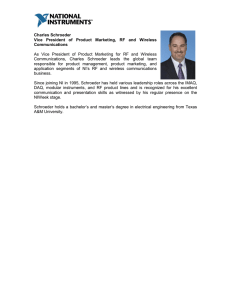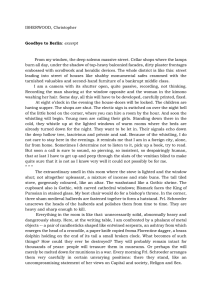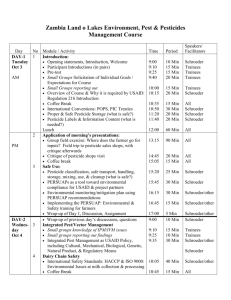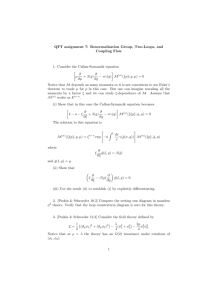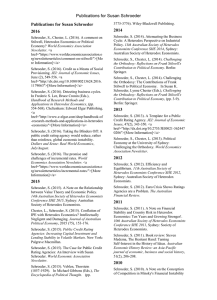Assignment 9 Physics/ECE 176 Made available:
advertisement
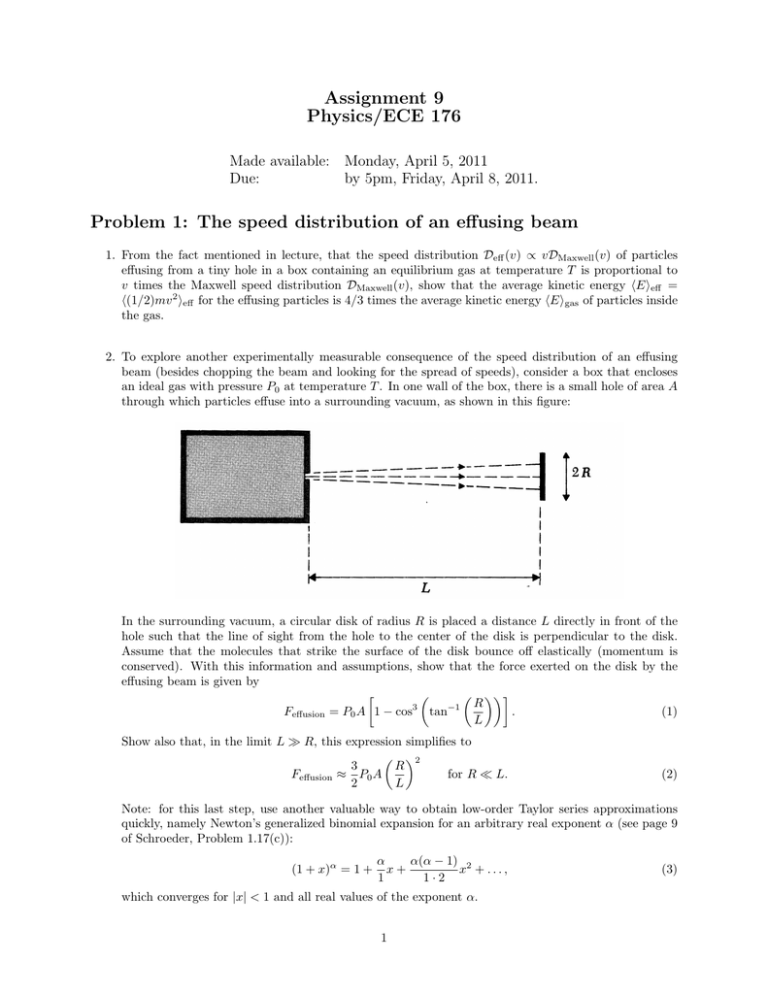
Assignment 9 Physics/ECE 176 Made available: Monday, April 5, 2011 Due: by 5pm, Friday, April 8, 2011. Problem 1: The speed distribution of an effusing beam 1. From the fact mentioned in lecture, that the speed distribution Deff (v) ∝ vDMaxwell (v) of particles effusing from a tiny hole in a box containing an equilibrium gas at temperature T is proportional to v times the Maxwell speed distribution DMaxwell (v), show that the average kinetic energy hEieff = h(1/2)mv 2 ieff for the effusing particles is 4/3 times the average kinetic energy hEigas of particles inside the gas. 2. To explore another experimentally measurable consequence of the speed distribution of an effusing beam (besides chopping the beam and looking for the spread of speeds), consider a box that encloses an ideal gas with pressure P0 at temperature T . In one wall of the box, there is a small hole of area A through which particles effuse into a surrounding vacuum, as shown in this figure: In the surrounding vacuum, a circular disk of radius R is placed a distance L directly in front of the hole such that the line of sight from the hole to the center of the disk is perpendicular to the disk. Assume that the molecules that strike the surface of the disk bounce off elastically (momentum is conserved). With this information and assumptions, show that the force exerted on the disk by the effusing beam is given by R Feffusion = P0 A 1 − cos3 tan−1 . (1) L Show also that, in the limit L R, this expression simplifies to 2 R 3 for R L. Feffusion ≈ P0 A 2 L (2) Note: for this last step, use another valuable way to obtain low-order Taylor series approximations quickly, namely Newton’s generalized binomial expansion for an arbitrary real exponent α (see page 9 of Schroeder, Problem 1.17(c)): (1 + x)α = 1 + α α(α − 1) 2 x+ x + ..., 1 1·2 which converges for |x| < 1 and all real values of the exponent α. 1 (3) Problem 2: Schroeder Problems 1. Problem 5.23, parts (a)-(c) on page 166. For part (b), you want to use the argument of pages 161-162 to show that the quantity Φ̃ = U − TR S − µR N decreases where TR and µR are the temperature and chemical potential of the reservoir. This is not quite the same as the Φ that Schroeder defines, which refers to the temperature and the chemical potential of the system. For part (c), you can use Eq. (5.35) on page 164 of Schroeder. 2. Problem 6.42 on page 249 of Schroeder. For part (b), determine whether your expression for the entropy is or is not consistent with the third law of thermodynamics. There are two ways one can solve part (a). Schroeder wants you to use the observation that the Helmholtz free energy F is an extensive quantity so F = N F1 if one has a system of N identical objects and F1 is the Helmholtz free energy for a single harmonic oscillator. Alternatively, you could use Eq. (6.69), that the partition function Z for a system with N weakly interacting distinguishable but similar components is Z = Z1N where Z1 is the partition function for a single particle. But F = −kT log(Z) which leads to the same result. Here we can treat the N quantum harmonic oscillators as distinguishable because, physically they are associated with nuclei that have different permanent locations in space. To help you check your algebra, the answer for part (b) is /kT S = N k β − ln 1 − e−β . e −1 (4) Contrary to what Schroeder says in part (b), this result is not “fairly complicated”. 3. Problem 6.45 This involves a brief amount of straightforward algebra, the purpose is to get you to “touch” the key formulas Eq. (6.92) and (6.93) at least once. When differentiating F to get S, don’t forget that the “quantum volume” vQ defined by Eq. (6.83) depends on T . 4. Problem 6.48 Do part (a) only. You will want to use Eq. (6.33) on page 236, the high-temperature rotation partition function for identical atoms. You should find that your theoretical prediction agrees well with the experimental value. 5. Problem 6.50 on page 255. Hints: Calculate the quantities in the order: U , H, Zint = Zrot , vQ , F , G, S = (U − F )/T , and µ = G/N . To one digit (but you should give two), the answers are: U ≈ 6×103 J, H ≈ 9×103 , J, Zint ≈ 50, F ≈ −5 × 104 J, S ≈ 200 J/K, and µ ≈ −0.5 AV. Make sure you understand the flow of logic so you can understand how to calculate all these different quantities. 6. Problem 6.52 on page 256. Schroeder’s hint is to follow the argument leading to Eq. (6.79) on page 253, i.e., to approximate the partition function by an integral. You should get the answer: Z1 ≈ 2LkT /hc. Problem 3: Time to Finish This Homework Assignment Please tell me the approximate time in hours that it took you to complete this homework assignment. 2
